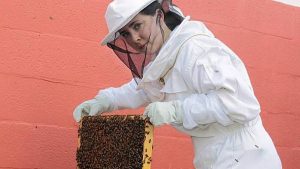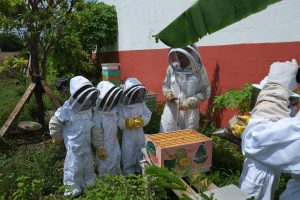Danielle Bender: Beekeeping, An Artistic, Accessible Approach

Danielle Bender of Public Hives got into beekeeping because she saw the potential of bees being a “catalyst to people getting more engaged with their communities.” Public Hives promotes community pollinators by placing beehives in neighborhoods and parks in Miami, Florida.
A couple years ago in Miami, there was a big Zika virus scare. Danielle noticed that there was a lot of aerial spraying for Zika going on but residents – many of whom walked everywhere, were older, and didn’t have access to the Internet or TV – were not being informed. Danielle got curious about this, noting in her neighborhood where there once were a lot of bees, there were no longer. She also noticed that she didn’t see grasshoppers or any other bugs any more.
“Communication makes communities stronger,” thought Danielle, and through her observation that the bugs were disappearing, she asked, “How do we get community members to communicate with each other and share information?” And how could she help provide opportunities for wildlife and the environment to flourish in her community?
As a grant writer and arts administrator, Danielle proposed a project for a public space challenge where folks could generate ideas to make the community a better place to live in. Her proposal was to do beekeeping in public spaces even though she wasn’t a beekeeper at the time. She got her start in beekeeping after doing lots of research, attending beekeeper association meetings, and contacting different beekeepers in the area.
“Just the idea of being able to experience beekeeping and doing that in the middle of the city in an urban environment, meeting neighbors, that was the main motivation and it’s worked out.”
“People have been really enthusiastic about this [public space challenge] and they are really curious about bees. Super curious,” says Danielle.
Public Hives commissions artists to paint the outside of hives and provide interesting workshops. They take a broader arts approach to spreading knowledge about bees that they feel reaches more folks in the community than a strictly science-based approach would. For example, they provided one group workshop where architects from the University of Miami’s women in architecture program designed different bee hotels to support native pollinators and another where they brought in two musicians that do experimental noise music to set up an interactive experience where people could plug in headphones and listen to the noises coming out of the bees.
As people sign up for workshops on their website, Danielle and the folks at Public Hives ask them what kind of programming they’d want to see in the future.
Many of these workshops are pretty intimate with about 13 people per visit (although they are looking to make these a little smaller for the sake of the bees). Danielle has noticed that in such visits people who come are “usually all strangers.” She says, “Being in a situation where you are in a vulnerable position, you’re nervous, you’ve maybe never been around bees before, or you’re excited because you’ve always wanted to be around bees…That makes people want to talk to the people around them.”
The Miami community is curious. “They want to know where their food comes from, they want to know processes, they want to be involved, they want hands on, and allowing them to do that really makes them more enthusiastic about the process itself.”
This intentional community focus extends to the speakers and artists Public Hives chooses to give workshops and events. “We try to choose artists that either identify with the space, or live and work in the neighborhood,” says Danielle. For example, in the Little Haiti neighborhood, “We had an artist whose name is Serge Touissant. He does murals all over and we commissioned him to paint the hive,” says Danielle. “So when he painted the hives, they’re very recognizably his style of art, and my friend and her son (both Haitian) [recognized] Serge’s work.”
Employing local artists in beekeeping workshops helps connect the practice with the neighborhood “because an artist from that neighborhood painted it” (in the case of the hive painting projects). In general, this community approach helps in “demystifying bees to someone that may have had a bad perception about [bees].” Danielle loves that this project is “a full circle opportunity to…get people meeting, demystify bees, and give opportunities to artists and beekeepers that live in the area.”

Public Hives also keeps it “local” whenever they host a honey harvesting workshop. They make sure that the demonstrations are led by a local beekeeper. They also center women and people of color when considering beekeepers to lead sessions, mentees, and artists. “Each beekeeper that leads a session is also simultaneously mentoring someone that may want to become a beekeeper. So, I make sure that any of the positions of someone leading a session is either led by women or POC.”
Danielle’s mission is to make sure this project goes beyond her as an individual “because that’s how things become stale, and that’s how people get burnt out.” Hence the emphasis on engaging the community on what kind of programming they would like to see and the focus on mentoring up and coming beekeepers to share in this wealth of knowledge, at places that naturally intersect for them.
“It’s just making sure that there’s room for other people to get involved.”
Media Attributions
- Danielle Bender © Danielle Bender is licensed under a All Rights Reserved license
- Danielle Bender with youth group © Danielle Bender is licensed under a All Rights Reserved license


Feedback/Errata